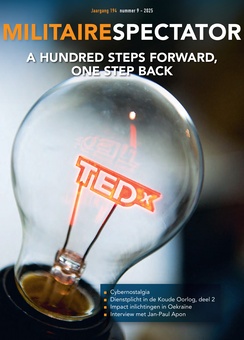What TED Talk would a leader give when she had internalized all the wisdom of the Top 30 Leadership TED Talks? This article follows a fictional TED Talk by the imaginary navy officer Anna. She had an idea for a new tactical unit at the technological edge. After taking the initial steps, she pushed forward and let the unit grow. Following this story, what key takeaways and leadership lessons can be learned from the top-thirty talks?
First, a note from the author. Last year I came across a visual that showed a Top 30 TED Talks on the topic of leadership.[1] After watching a few, I noticed that they were so valuable that I started to take notes of each talk’s main takeaways. Over the course of weeks, I watched all of them. Meanwhile, I was taking a creative-writing course to broaden my academic writing skills. During one of the classes, I asked myself what TED talk leaders would give when they had internalized all the wisdom of the Top 30 Leadership TED Talks? Would it be possible to write a TED talk about thirty TED talks? I assessed that it might be possible and made an attempt. As such, this article is a fictional TED talk by the imaginary navy officer Anna. She had an idea for a new tactical unit at the technological edge. After taking the initial steps, she pushed forward and let the unit grow into adulthood. While she tells her story, she weaves in the main takeaways of each of the thirty talks.
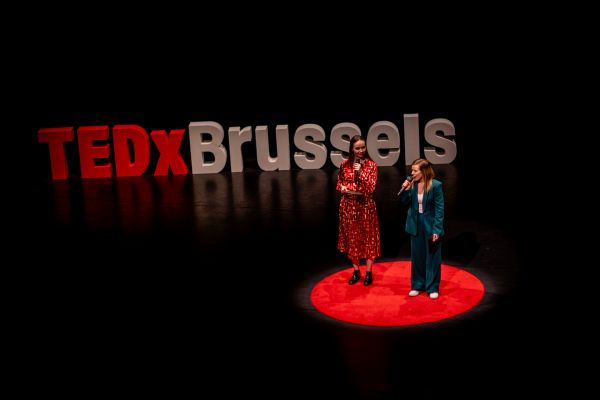
Two speakers at a Tedx conference stand on the iconic circular red carpet. This article offers lessons for leadership by recounting a fictional TED Talk. Photo Mélanie Meinbach
Anna’s TED Talk
‘This is Emma’, Anna slowly said. She turned her head towards the giant screen behind her and looked at it. ‘She was the first who joined our unit. And, she is a dear friend of mine’, Anna continued with a warm smile. She turned her head back to the audience and took a few steps forward on the bright red, circular carpet.
‘Emma and I met on a Navy vessel’, Anna spoke with a soft voice. ‘We quickly discovered that we both were a bit geeky and loved gardening. Emma was raised in a farming family in Zeeland where generations innovated against floods.’ Anna continued to speak about how she gradually dared to share more about her idea. And, to her surprise, ‘Emma was thrilled by the idea to innovate with bold tech. If I needed somebody on my team, she would be in, she declared.’ Their shared excitement rapidly evaporated the reservations Anna had developed to speak about her idea.
‘My idea was actually rather simple’, Anna said with a serious face. ‘What we normally did, was that we looked at the data that we already had’, Anna started to explain. ‘We then trained a matching artificial-intelligence model on that data to get a well-working algorithm’, she continued. ‘And, then, we started to look for a useful application of that algorithm.’ Anna raised her eyebrows, widened her eyes, and opened her hands.
‘In my mind’, she spoke slowly again, ‘we needed to turn this logic around.’ Anna paused for a moment to let her point sink in. ‘In fact, we first needed to identify the algorithms that would give us a definitive advantage on the battlefield and then collect the required data.’ While speaking, she took a firm stance and raised her right arm in front of her chest. Her clenched wrist pulsed with earnest conviction, echoing the grounded power pose. ‘I believed that an operational unit at the intersection of artificial intelligence and data collection was going to play an essential role in the future of warfare’, Anna said at a slightly faster pace.[2] [3] The audience sensed her conviction.
‘Lead by example’ is a truism for both leaders and followers: followers tend to mimic followers. Photo MCD, Hille Hillinga
‘Before Emma joined, I did what I was used to do. I wrote an email about my broad idea and sent it into the command line’, Anna recounted. Her voice became more excited. ‘But, unfortunately, the focus wasn’t where I expected it to be. We debated words and sentences. Or, proper procedures and budget cycles.’ Anna briefly paused and then continued, ‘Only later I realized that these experiences helped me to uncover my grit.’
‘This is Bronco. Another dear friend’, Anna introduced. Her voice slowed down to signal that she shifted gears. She watched over her right shoulder to the huge screen behind her. The displayed picture showed her with the paws of her giant German shepherd dog on her chest. She smiles brightly, looks him in the eye, and has her nose to his nose. Her hair nicely matches the colour of a large patch on the dog’s side. ‘While I love Bronco, he is also a passionate digger who can destroy the magnificent flower beds in our garden in minutes’, Anna grieved, her voice touched with sadness. ‘Emma and I sometimes walk through our gardens to appreciate the beauty, but…’ Anna trailed off, looking down, ‘we learned that it’s better to keep Bronco inside the house.’ Laughter erupted. Anna grinned painfully. ‘Planting seeds and letting them grow, is the first step to big and beautiful flowers’, she concluded with a barely visible smile. ‘Now reflect on what seeds you planted and describe the flowers to the person next to you’, Anna asked. After a brief moment of sharing, people quietened in anticipation.
‘Over time’, Anna said to the audience in the darkened hall, ‘Emma proved to be my first follower.[4] Her studies in Delft made her an excellent fit for our mission. After she joined my team, I noticed that others became curious as well. The speed at which people applied picked up.’ Anna briefly paused and took two steps to the left. She stood on the edge of the red circular carpet. ‘And, you know what’, Anna continued. She slightly raised her chin and peered into the audience. She noticed that she clearly saw the listeners at the first two rows. ‘I learned that the often-used phrase “lead by example” is a true-ism for not only myself as a leader but also for Emma as a follower. While watching people flooding in, I learned that followers tend to mimic followers.’ Anna’s face turned happy again. She continued to share that the group steadily grew and started to form a tribe with a clear mission: collect data to build combat-effective algorithms.[5]
‘However’, Anna said with the seriousness of before, ‘we also started to face challenges. Although we had a promising algorithm in mind, the early joiners wanted to take the next step and actually conduct operations to collect the data.’ She then shared how the broad initial idea got stuck in the bureaucratic swamp. ‘Daring to disagree with the “no’s” that we got, built our resolve even more’, Anna said. Her upper body and arms stiffened while her fists clenched and knuckles whitening, revealing that determination surged through her veins.
‘Some of the early team members seemed to get discouraged and openly speculated about leaving.’ Anna paused again and now looked concerned. Her body softened and shoulders eased from the power hold. As she glided two steps back to the middle of the circular carpet, her breath steadied. ‘I decided that conducting operations was the single most important thing to do. For the team. And more importantly, for the mission’, she said. Anna looked happy with the decision she had taken. ‘The next step that we patiently needed to take was to train ourselves in the skills that we needed on operation’, Anna confidently told the audience. She moved her hands in front of her belly, stretching her fingers before slowly drawing the fingertips together. ‘This was a period of trial and error. However’, Anna said while making herself vulnerable to critics, ‘I didn’t have all the answers. The military had become risk-averse, demanding painstaking detail to raise efficiency. But we were in uncharted waters where I chose for the power of iteration: test ten variations, select the best, test another ten variations, select, and so on.’[6]
‘So, while war is a zero-sum game, training for war and developing our algorithm isn’t’, Anna explained to her team. ‘We need failure to cultivate our growth mind set, turning every speed bump into a chance to learn, improve, and reach our distant destination. This training was about succeeding, the future operations about winning’, she emphasized.[7] ‘I felt that one of my most important tasks during this training period was to let my people feel safe’, Anna reflected, her warm gaze mirrored her open posture.[8] ‘If this was a game and people wouldn’t know the score, what would they see?’, she regularly asked her team members, signalling that the way of succeeding mattered as well. ‘Was this perfect?’, she asked herself on the stage. She briefly looked into the darkness in front of her and took a step forward. ‘No, not at all! It was messy with heated debates where we deconstructed and rebuilt ideas like Lego’, she continued, her face etched with a determined grimace, channelling unyielding focus. Anna turned around and looked at Emma’s picture on the screen.
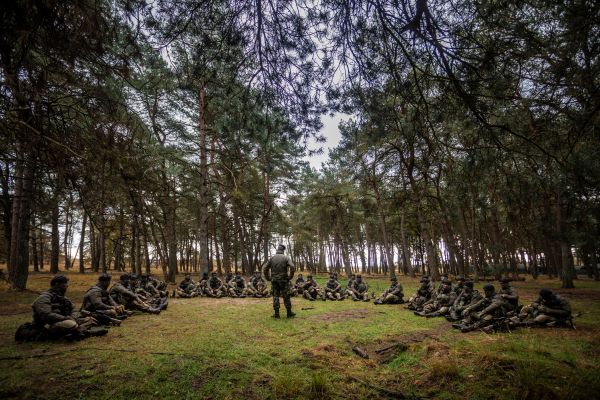
Being vulnerable provides safety and trust within a team. Photo MCD, Jarno Kraayvanger
‘But team members such as Emma, who dared to speak truth to power, proved to be invaluable. She conveyed messages in the right tone and at the right moment. In a way, it felt like being a parent’, she confessed. ‘I relentlessly prioritized the interests of the team. Just as I do with my eight and eleven-year-old sons, Daan and Gijs’, she added with the soft smile of a loving parent.[9] ‘And, I had discussions like I had with Gijs who is at the brink of entering puberty’, Anna admitted with a slow and agitating voice. The audience broke into laughter. ‘I learned that being vulnerable during ruthless evaluations provided both the necessary safety and the crucial trust within the team’, she said with a voice of appreciation.[10]
‘By now, my broad initial idea had much more focus. We had a purpose. We had a team. We had practiced. We also had a couple of specific algorithms in mind and a directional idea of what the data requirements were. In other words, we were ready to go on operation’, Anna firmly said. Her bowed arms and clenched fists in front of her body pulsed with energy and anticipation. Her grounded pose radiated readiness. ‘I started to pitch the refined mission to my commanders during large staff briefings’, Anna continued. ‘As a tech introvert, this pushed shivers over my spine.’ Anna’s face now twisted with extreme anxiety, eyes widening with vulnerable intensity. Her body stiffened visibly while her shoulders recoiled from an invisible weight.
‘I was so scared as hell that I took classes’, Anna cautiously admitted. ‘Classes that would help me to convey my message in a way that people would listen.’[11] She confessed, her face still hesitant, ‘Even before this talk, I did what I started to do after these classes. Make my body giant for two minutes.’ She raised her arms and expanded her frame wide like a blooming flower. ‘Like this’, she said. ‘It looks silly, but it floods my body with confident energy. Even when you walk into a board room for a meeting.’[12] While lowering her hands and smiling, she continued, ‘but, don’t try this at home’, she joked. ‘I felt that I needed to push myself even further and also started to pitch the idea to other people’, Anna said, increasing volume to regain attention. ‘However, during some meetings, I got a seat on the second row.’ She looked furious, eyes flashing with flaming intensity, and took two firm steps forward. She stood on the carpet edge again with a commanding stance, but was still brightly lit by the stage lights. She stood still and peered towards the audience. ‘While I learned to demand a seat at the table, I also continued to attend other training programs. I wanted to get better.’[13]
‘These classes not only helped me how to speak out but perhaps more importantly, who to speak to’, Anna said as if she was struck by a lightning bolt. ‘I learned to speak to the innovators and early adopters’, she continued. ‘I was amazed to notice that my teachers were right. These people did tell their friends! They did become our biggest supporters.’[14] ‘Slowly but surely, the tide seemed to turn’, she proclaimed, her voice proud and happy. ‘And, very slowly my anxiety started to wane.’ After a firm initial hesitation within the bureaucracy, Anna eventually received permission to conduct one reconnaissance mission.
‘When we came back from this mission, we had data’, Anna said. She beamed like a triumphant German shepherd dog returning with the prized stick, tail-wagging joy in her eyes. ‘But the disbelievers outside our team started to argue that we hadn’t been successful, because it hadn’t led to a working algorithm’, Anna said with a low and disappointing voice. She continued that the naysayers also brought up the argument that contemporary doctrine prescribed that reconnaissance missions were supposed to support the gathering of intelligence or the preparation of operations. Not to collect data for algorithms.
‘We had collected the right data’, Anna firmly argued to her commander. She looked annoyed by now, lips pressing into a thin line and eyes conveying bubbling impatience. ‘However, the data hunger of this potential combat-effective algorithm is orders of magnitude higher. And, we need to trial and error much more to find the optimal combination between the data and the algorithm. So, we need to conduct more reconnaissance missions.’
‘We advanced through our tribe stages by fierce, persistent debates during a multiple-day decision-making process, but eventually received permission to conduct five more missions’, Anna said. Once this wheel started to turn, it transformed into a ferocious flywheel that spanned beyond her imagination. The much anticipated data gushed in as if the operational teams opened a fire hose. The algorithm testing started to show unexpectedly interesting effects. At the same time, Anna desperately needed more people in their team and felt that they had entered unknown territory more than ever. As such, she decided to select new team members solely on their ability to diligently work towards long-term goals.[15]
‘At that very moment, I also decided that I wouldn’t hide my ignorance anymore’, Anna said. She stood straight up with her chest proudly raised, embodying a vulnerable power pose. Anna continued to share that she had seen how a previous commander had turned his vulnerability into strength and she was committed to doing the same.[16] ‘But showing my vulnerability wasn’t enough’, Anna said. ‘I deeply felt that if I took extreme ownership of everything that happened in and by our team, it would send a strong signal’, Anna now softly spoke with a heavy voice.[17] Her hands hung loosely next to her body. She still stood straight up, but her proud chest had eased back slightly. ‘In our team, we listen and learn, leaving egos or glory at home. We needed team players and team leaders’, she said. ‘Team leaders who treated their team members as partners.’[18] She then waited and let the tension in the audience rise.
‘We needed leaders who gave their team the capabilities to do well. Leaders who made sure that everybody was included. Leaders who set the stage so that their people could perform.’[19] She heard a loud applause erupt. Anna smiled and slightly bowed her head. ‘And, think of a person who created such a feeling for others. Whisper it to your neighbour’, Anna asked, feeling that the interactions deepened connections. ‘After these five missions, we had proven the basic concept of the idea’, Anna said. ‘And, we had grown to a thirty-people tribe.’ She briefly paused, took a step, and looked at the audience again.
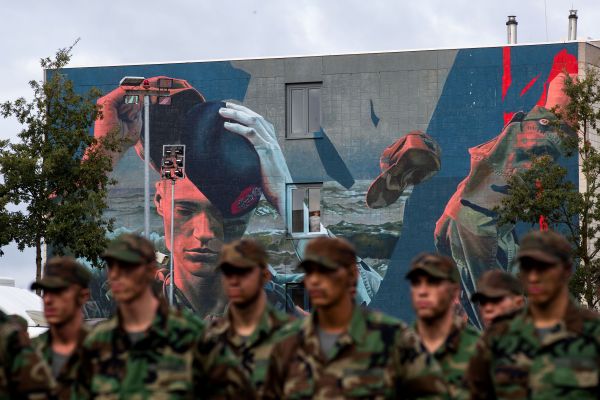
Purpose, autonomy, and mastery are core principles to increase motivation. People want to contribute to something larger than themselves. Photo MCD, Jasper Verolme
‘Besides that, we all scored high on grit. We desperately wanted to maintain this high level of motivation within our team. But how?’, Anna openly asked herself, eyebrows bowed in questioning arcs and hands raised into the air palms up. She continued to describe how they hotly debated various options within the team and eventually arrived at three core principles: purpose, autonomy, and mastery.[20] Within the team, they believed that people want to contribute to something larger than themselves, that people want to make choices about their own lives, and that people want to become better in what they do.
‘As a geeky person myself, I wasn’t completely sure about these principles. They felt a bit soft’, Anna proclaimed, her face still doubtful. ‘But, I decided to give it a go.’ The team went on to conduct operations, collect data, develop algorithms, and steadily grew to sixty people. ‘After my initial hesitation, I admitted to the team that my notions of motivation had been rather dated. These core principles proved to work really well. We needed to keep these’, Anna declared proudly. ‘And, another clear takeaway for me was that I first needed to listen to my team, learn from them, and then lead’,[21] she reflected with a soft voice, bowing her head with a humble grace.
‘While reflecting on this period, I notice two more things’, Anna said. ‘First, our approach to motivation raised the feeling of ownership to a level that we hadn’t experienced before. This feeling subsequently elevated trust among each other. And second, people seemed to feel happy’, Anna said surprised, her eyebrows shooting up while her eyes widened, capturing a spark of delight. ‘When we dug a little deeper, we uncovered what drove this feeling of happiness’, she said. ‘In the very beginning of our team, we decided to take on a twenty-one-day challenge to exercise, meditate, and share gratefulness daily’, Anna dryly noted,[22] ‘Without much effort, we got used to telling people around us how they improved our lives.’[23] ‘This challenge was for fun and we forgot about it’, Anna shared as a boring fact. She walked to the edge of the stage just outside the stage light bubble and scanned the faces of the people in front of her. ‘But, you know what, this experiment ingrained habits that proved to be essential for our happiness’, she said astonished.
‘The other gem that we uncovered was meaning. As a team, we delivered a product that saved lives on the battlefield! How awesome is that?’, Anna asked.[24] She raised her hands in the air as if she received a precious gift. She looked so happy. ‘Then, during some meeting, my commander took me aside’, Anna said puzzled, her expression unveiled confusion. She noticed being outside the stage lights and slowly walked back into the yellow beams. Her steps were deliberate, realigning her posture with the red carpet. ‘You know that more than a hundred and fifty people need some level of formality and bureaucracy?’, he had asked her, Anna recalled. ‘This question that wasn’t a question made me think really hard’, Anna said a little annoyed. Her jaw tightened subtly, tapping fingers against her side. ‘Although I felt like a parent, I didn’t want to treat our team as a boarding school’, she firmly said. ‘I wanted sensible rules that maximized autonomy and creativity.’[25]
‘I went back to Emma and the rest of the team to discuss what just had happened’, Anna said. ‘Emma developed her Rotterdam grit at her first job in a shipbuilding company next to a collaborative ethos.’ Anna took a step and opened her arms to show her invitation to her team. She then spoke about how they quickly agreed that her boss had made a good point. And, that they discussed questions such as: Who do we want to be? What values do we have? Why do we exist? What rules best enable us?
‘After intense discussions, everybody agreed that we were committed to our unit. We believed in our cause. We lived a life in immersion’, Anna said warmly.[26] ‘But, at the same time, we also agreed that we felt desperate to have another life. A personal life to be present for our families, friends, and loved ones. To spend time on hobbies and sports’, Anna continued with a critical voice and a thoughtful expression on her face. ‘So, we decided to balance between these two lives of immersion. In essence, this balance would become core to our organization’, Anna affirmed happily. ‘We also decided that we wanted to focus on process automation as much as possible. This would slow down the number of people that we needed and avoid us growing beyond the one hundred and fifty people soon’, Anna continued, still content.
‘So said, so done’, Anna transitioned, ‘But, unfortunately, the next challenge already appeared on the horizon.’ She shared how they had taken in many people on the team in a short time. Although they had selected these people on grit and fit into the team, they also started to experience cracks in their thus-far close-knit team. ‘We deliberately looked for high-achieving team players, but discovered that we had unconsciously selected a few individuals with star allures’, Anna said, looking disturbed, her posture shadowing with unease. She paused briefly, drawing a deep breath, and then continued, ‘These few were takers. Not givers. They were withholding. Not sharing.’ Anna’s body shrunk and her head bowed agitated. ‘For us, this was a painful lesson. To heal the cracks, we needed people who gave more to each other than they wanted to receive. We needed givers. Not takers’, Anna said, ‘So, just as with Bronco, keep the takers out of your garden.’ [27] She aired being glad about the outcome. She stood prominently in the middle of the red circle.
‘For me personally, there was another painful lesson’, Anna now looked anxious, her eyes revealing with inner turmoil. Her body slowly shrunk, shoulders curling inward as vulnerability increased visibly. ‘The beginning cracks were also infused by something different. Some of the many givers on the team worked so hard that they started to show signs of burnout’, she said, ‘This unfortunate conclusion made me aware that having a balanced work-life strategy and meaning for our team wasn’t enough.’ Anna paused and shifted her weight on her left leg. ‘I, as a leader, needed to protect my team against the constant flow of overly long days, unnecessary email bombardments, and over-allocation of tasks’, Anna said, ‘I also needed to provide more silent spaces to the introverts such as me to retreat and think deeply. They were just overwhelmed by the endless drumbeat of meetings.’[28]
‘Fast forward a couple of years. The unit did reach the number of one hundred and fifty people. The unit did deliver dozens of combat-effective algorithms. The unit does have the highest scores on all thinkable work-satisfaction questionnaires within the military’, Anna said proudly. Her chin lifted with assurance, radiating accomplishment in a grounded pose. ‘It’s time for them to move on. They need to tell their stories now. Not that one single story of me’, she said while expressing a mixture of sadness and pride.[29] ‘Other countries showed interest in the concept too. We had fantastic people who could tell their stories in those languages in a way far better than I ever could have done. How great is that!’, she said.[30]
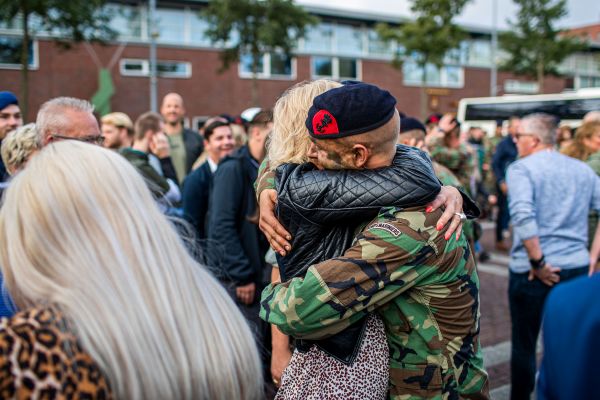
A healthy balance between professional and personal life is beneficial to a team’s performance. People need a personal life to be present for their families, friends, and loved ones. Photo MCD, Jasper Verolme
‘So, while I stepped back and moved to my next position’, Anna said, ‘I also want to leave you with a message. My call to action is that you sow seeds and tend the flowers until they are as big as you. Then take a step back to grant them more sunlight and enjoy seeing them grow even taller and become more beautiful.’ A loud applause swells to the stage. ‘Thank you!’, Anna smiled relieved and bowed before the stage lights dimmed.
Epilogue
After reading Anna’s story with the woven-in thirty main takeaways, the next logical questions may be: So what? Does the ideal leader exist? When I zoom out and reflect, I conclude that leaders need to have a clear destination and an exciting reason to go there. Just like Anna did, turning AI logic around to gain a battlefield advantage. The latter is important because the paths that lead to these destinations often prove to be rocky, unpredictable, and dangerous. Anna needed to navigate bureaucratic swamps to plot her unit’s route. Even worse, some paths aren’t there yet and need to be carved out, like forging new data-collection missions.
What I also distilled from the talks is that leaders need to be relentlessly open to the people they meet on these paths, the feedback that these people provide, the places that they encounter, and the responses that their actions invoke. Leaders must be as open as Anna was to Emma and her team. They need to weed through these inputs continuously and pick those that help them move forward, even those from the disbelievers and hurdle imposers. In the end, leaders may even conclude that the destination and its reason for going there may have become larger than themselves, much like the ‘why’ of Anna that now belongs to the team. Similarly, this is much like start-up founders outside the military who tend to pivot regularly to find a market fit for their product. Such a start-up team then tends to grow into a scale-up enterprise. This may be the moment to step back and propel your team forward.
[1] Thanks to Justin Mecham for the compilation; ‘One talk wasn’t a TED talk’, see: https://www.linkedin.com/posts/justinmecham_top-30-leadership-ted-talks-of-all-time-activity-7149754047997091840-Pw0w.
[2] Rose Linde Torres, ‘What makes a great leader’, see: https://www.ted.com/talks/roselinde_torres_what_it_takes_to_be_a_great_leader.
[3] Fields Wicker Miurin, ‘Learning from leadership's missing manual’, see: https://www.ted.com/talks/fields_wicker_miurin_learning_from_leadership_s_missing_manual.
[4] Derek Sivers, ‘How to start a movement’, see: https://www.ted.com/talks/derek_sivers_how_to_start_a_movement.
[5] David Logan, ‘Tribal leadership’, see: https://www.ted.com/talks/david_logan_tribal_leadership.
[6] Tim Harford, ‘Trial, error and the God complex’, see: https://www.ted.com/talks/tim_harford_trial_error_and_the_god_complex.
[7] John Wooden, ‘The difference between winning and succeeding’, see: https://www.ted.com/talks/john_wooden_the_difference_between_winning_and_succeeding.
[8] Logan, ‘Tribal leadership’, see: https://www.ted.com/talks/david_logan_tribal_leadership.
[9] Simon Sinek, ‘Why good leaders make you feel safe’, see: https://www.ted.com/talks/simon_sinek_why_good_leaders_make_you_feel_safe.
[10] Linda Hill, ‘How to manage for collective creativity’, see: https://www.ted.com/talks/linda_hill_how_to_manage_for_collective_creativity.
[11] Julian Treasure, ‘How to speak so that people will listen’, see: https://www.ted.com/talks/julian_treasure_how_to_speak_so_that_people_want_to_listen.
[12] Amy Cuddy, ‘Your body language may shape who you are’, see: https://www.ted.com/talks/amy_cuddy_your_body_language_may_shape_who_you_are.
[13] Sheryl Sandberg, ‘Why we have too few women leaders’, see: https://www.ted.com/talks/sheryl_sandberg_why_we_have_too_few_women_leaders.
[14] Seth Godin, ‘How to get your ideas to spread’, see: https://www.ted.com/talks/seth_godin_how_to_get_your_ideas_to_spread.
[15] Angela Lee Duckworth, ‘Grit: The power of passion and perseverance’, see: https://www.ted.com/talks/angela_lee_duckworth_grit_the_power_of_passion_and_perseverance.
[16] Brene Brown, ‘The power of vulnerability’, see: https://www.ted.com/talks/brene_brown_the_power_of_vulnerability.
[17] Jocko Willink, ‘Extreme ownership’, see: https://www.youtube.com/watch?v=Qnr_VW-AuI4.
[18] Itay Talgam, ‘Lead like the great conductors’, see: https://www.ted.com/talks/itay_talgam_lead_like_the_great_conductors.
[19] Jim Hemerling, ‘5 ways to lead in an era of constant change’, see: https://www.ted.com/talks/jim_hemerling_5_ways_to_lead_in_an_era_of_constant_change.
[20] Dan Pink, ‘The puzzle of motivation’, see: https://www.ted.com/talks/dan_pink_the_puzzle_of_motivation.
[21] Stanley McChrystal, ‘Listen, learn…and then lead’, see: https://www.ted.com/talks/stanley_mcchrystal_listen_learn_then_lead.
[22] Shawn Achor, ‘The happy secret of better work’, see: https://www.ted.com/talks/shawn_achor_the_happy_secret_to_better_work.
[23] Drew Dudley, ‘Everyday leadership’, see: https://www.ted.com/talks/drew_dudley_everyday_leadership.
[24] Dan Ariely, ‘What makes us feel good at work’, see: https://www.ted.com/talks/dan_ariely_what_makes_us_feel_good_about_our_work.
[25] Ricardo Semler, ‘How to run a company with (almost) no rules; Radical wisdom for a company, a school, a life’, see: https://www.ted.com/talks/ricardo_semler_how_to_run_a_company_with_almost_no_rules.
[26] Jacqueline Novogratz, ‘Inspiring a life of immersion’, see: https://www.ted.com/talks/jacqueline_novogratz_inspiring_a_life_of_immersion.
[27] Adam Grant, ‘Are you a giver or a taker?’, see: https://www.ted.com/talks/adam_grant_are_you_a_giver_or_a_taker.
[28] Susan Cain, ‘The power of introverts’, see: https://www.ted.com/talks/susan_cain_the_power_of_introverts.
[29] Chimamanda Ngozi Adichie, ‘The danger of single story’, see: https://www.ted.com/talks/chimamanda_ngozi_adichie_the_danger_of_a_single_story.
[30] Lera Boroditsky, ‘How language shapes the way we think’, see: https://www.ted.com/dubbing/lera_boroditsky_how_language_shapes_the_way_we_think?audio=en&language=en.
